CNS Cells (Chapter 2b)
1/71
There's no tags or description
Looks like no tags are added yet.
Name | Mastery | Learn | Test | Matching | Spaced |
|---|
No study sessions yet.
72 Terms
Neuron communication
electrical and chemical - how cells communicate -->
Electrical signal
Within the cell is electrical (e.g. communicating by action potential)
electrical - inside
Chemical signal
Between cells is chemical (e.g. communicating neurotransmitters)
chemical - between
Principles of electricity
-->
Voltage
- Difference in charge between two points (inside and outside of the cell).
- finding voltage is measuring charge difference between inside and outside of the cell.
(if there's a difference, that's stored energy)
Current/flow
The movement or flow of electrically charged particles.
- is there a voltage different? (energy to move?)
- resistance? (is there something blocking that movement?0
Ohm's law
Current (I) = Voltage (V)/Resistance (R)
Ion
fall into two categories (pos + neg)
Anions
negatively charged ions
Chloride (CI-)
CI-, an anion
Cations
positively charged ions
Sodium (Na+)
Na+, a cation
Potassium (K+)
K+, another cation
Calcium (Ca2+)
Ca2+, a third cation
What determines an ion's charge?
p = proton, p = positive (positive ions have more protons).
e electron, e = negative (empty) = (negative ions have more electrons).
Ion distribution across the membrane + location of negatively charged proteins (A-)
- different distribution gives voltage difference across the cell (between inside and outside of the cell)
- combos of ions that determine whether or not cell is negative or positive overall.
- always will have more positive on outside of cell than inside of cell when it's at rest.
e.g. for exam questions: calcium is more concentrated at rest.
or inside is more negative, outside is pos.

Neuronal membrane/Phosophilid bilayer
The physical barrier that limits what can pass what goes inside and outside of the cell.
- establishes where ions are sitting when the cell is not doing anything.
Hydrophilic
water liking elements (hangs out on outside of neuronal membrane)
Hydrophobic
water hating elements (tucked inside neuronal membrane)
Membrane permeability
selectively permeable- only some substances are allowed
to enter and leave across membrane
Membrane polarization
Difference in electrical charge (inside = negative, outside = positive).
(image is where cells should live when they are at rest)
many, few, many many few
sodium, potassium, chloride calcium proteins

Intracellular fluid
fluid within cells
Extracellular fluid
fluid outside the cell
Resting potential
The difference in electric charge between the inside and outside of a neuron's cell membrane.
Ion movement
driven by diffusion and electrostatic forces: need this to drive between intracellular and extracellular space.

Diffusion
Keeps moving ions until uniform concentration is achieved (equal concentration between spaces).
Electrostatic pressure
Negatively charged and positively charged ions will be attracted to each other - pos/pos and neg/neg will repel one another.
How does neuronal membrane affect this?
Permeability - more permeable to K+ than Na+.
Distribution and forces
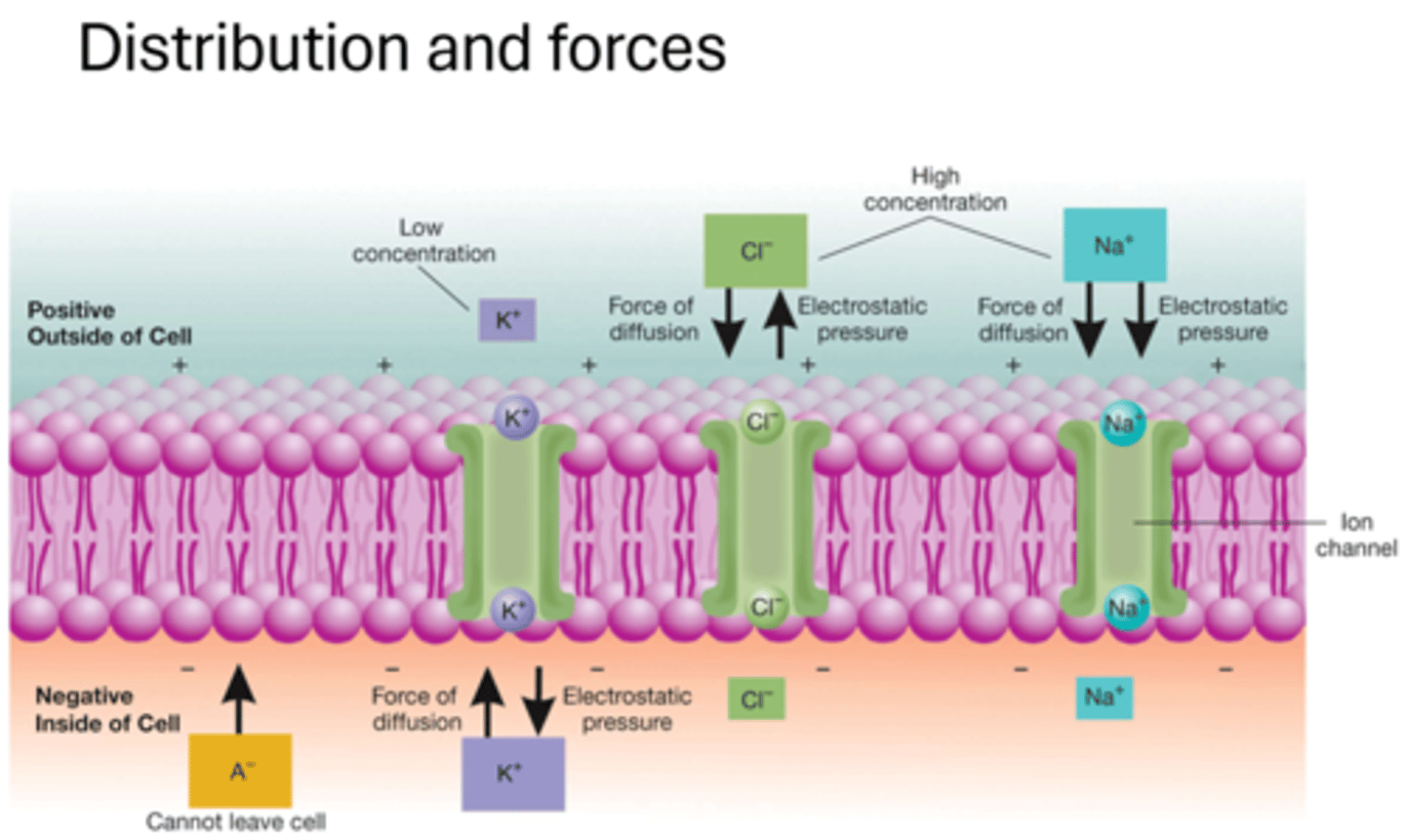
Ion channels
- made up of protein subunits that link together.
- between units, there are ion channels (or ion pores).
- different selective channels for every single ion (e.g. potassium channel, chloride channel, etc.)
- most often these channels are closed
- movement of ions through channels are passive --- channels do not move ions. diffusion or electrostatic pressure has to force them through.
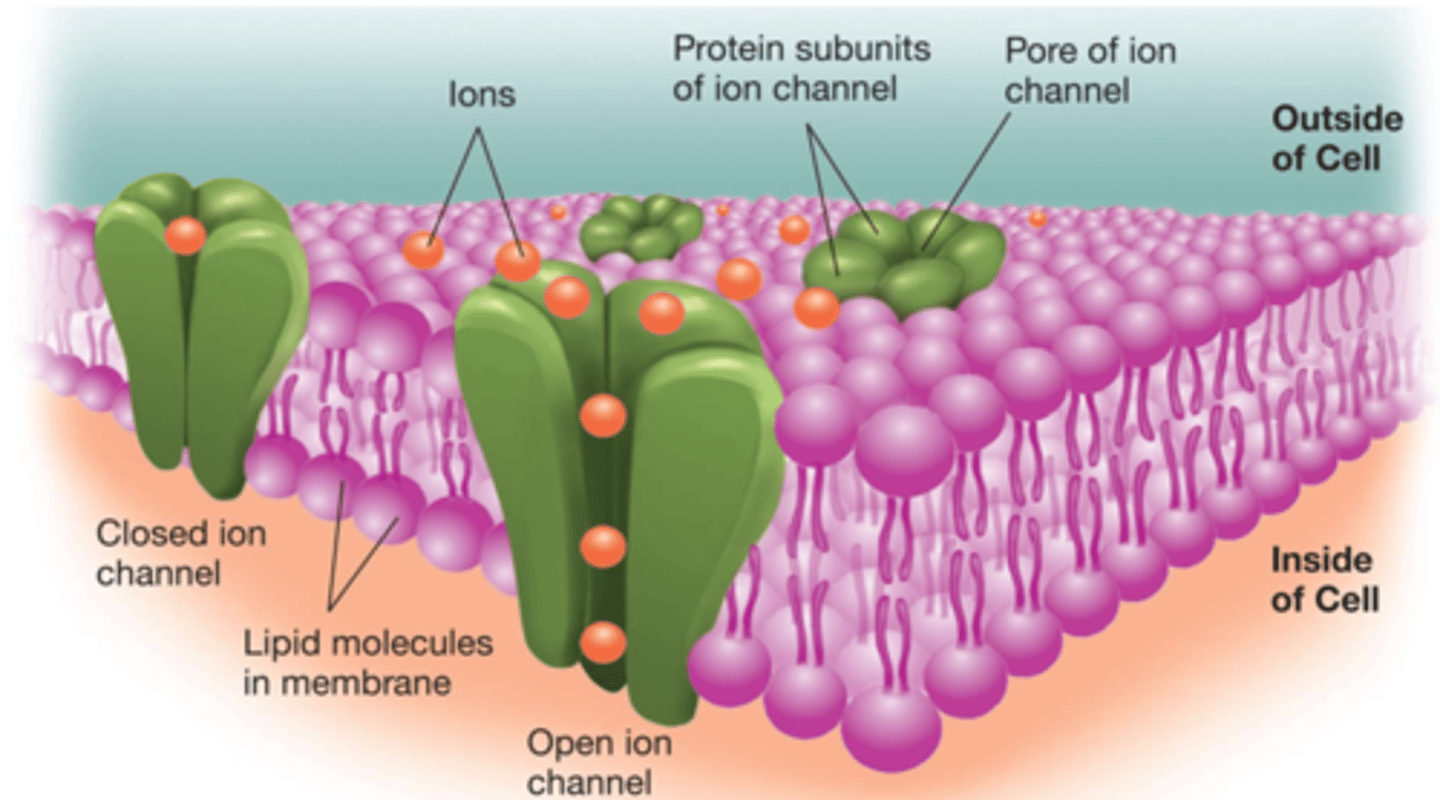
Voltage gated/gated
- gating is the stimulus activates the channel and allows it to open and close.
- in response to changes in membrane potential.
- still need diffusion or electrostatic pressure to move ions.
-if u have open channel and concentration difference/difference in charge, theres going to be diffusion or electrostatic pressure equalizing things
Ion pumps (transporters)
pumps use a ton energy to push against diffusion or es pressure. active transport, not passive. their goal is to push ions back to resting potential/resting state. constantly at work.
- close to half of all energy that brain uses goes to these pumps!! they're very important.
- selective for different ions, just like channels.
Sodium-potassium pump
pumps use energy to push sodium back outside.
- always three sodium out, two potassium in.
Change in membrane potential (resting potential)
- average rp is -70 millivolts.
- because there is a voltage difference, the cell is active.
- if it was 0, the cell would be dead!
-negative inside, positive outside.
Hyperpolarization, exaggerating the polarization
making it more negative, with a greater difference between the inside and outside, and getting farther from 0 mv.
- trying to block electrical signals.
- inhibitory, stop sign.
- driven by

Depolarization, reducing polarization
making it less negative, less difference between inside and outside, closer to 0 mv.
- making electrical signals.
- trying to get the cell to work and communicate.
- driven by ion movement.
basically increases the likelihood of generating an action potential.
Action potential (AP)
the message (electrical signal) that gets sent along the axon.
- always start at the hillock and run down the axon proper to the terminal!
- change in the resting potential generates a neurotransmitter release.
at peak of action potential, more positive inside
Steps of a membrane potential, need to know names of all of these
1. starts at resting state
2. Threshold: starts the process (threshold of excitation) - channels pop open and sodium rushes inside. need to move at least 15 mV. Hits threshold at: -55 to -40 mV
3. Rising Phase: Voltage-gated sodium channels
• Threshold exceeded • Na+ influx
4. Overshoot: Depolarization flips so it's more positive on inside than it is on the outside (rising phase - all driven by sodium entering the cell). sodium channels close at its peak. HOWEVER. potassium channels open up. basically change in voltage acts as signal to open sodium channel at around -55 mV.
5. Repolarization or FALLING STAGE: (more negative); potassium channels open and it begins to leave. when potassium channels open, diffusion wants to push it outside of the cell. the cell at this point is more positive inside, so diffusion and es want to push it outside of the cell, even though its more concentrated inside than out. "Exiting" of potassium from inside cell to outside, eventually making it more negative.
6. Undershoot, afterpotential: brief hyperpolarization where a little too much potassium exists the cell. so were hyperpolarized now.
and then back to resting state.
positive ions in a negative space = major action potential!

Better image of a membrane potential
sodium is trapped inside there!
helps to recharge action potential.
open = EXITING.
more sodium concentrated on the inside, more potassium concentrated on the outside.
normally positive on the inside, now negative.
exam question ex.: "what would happen if i opened up a sodium channel at this point in the membrane potential?"
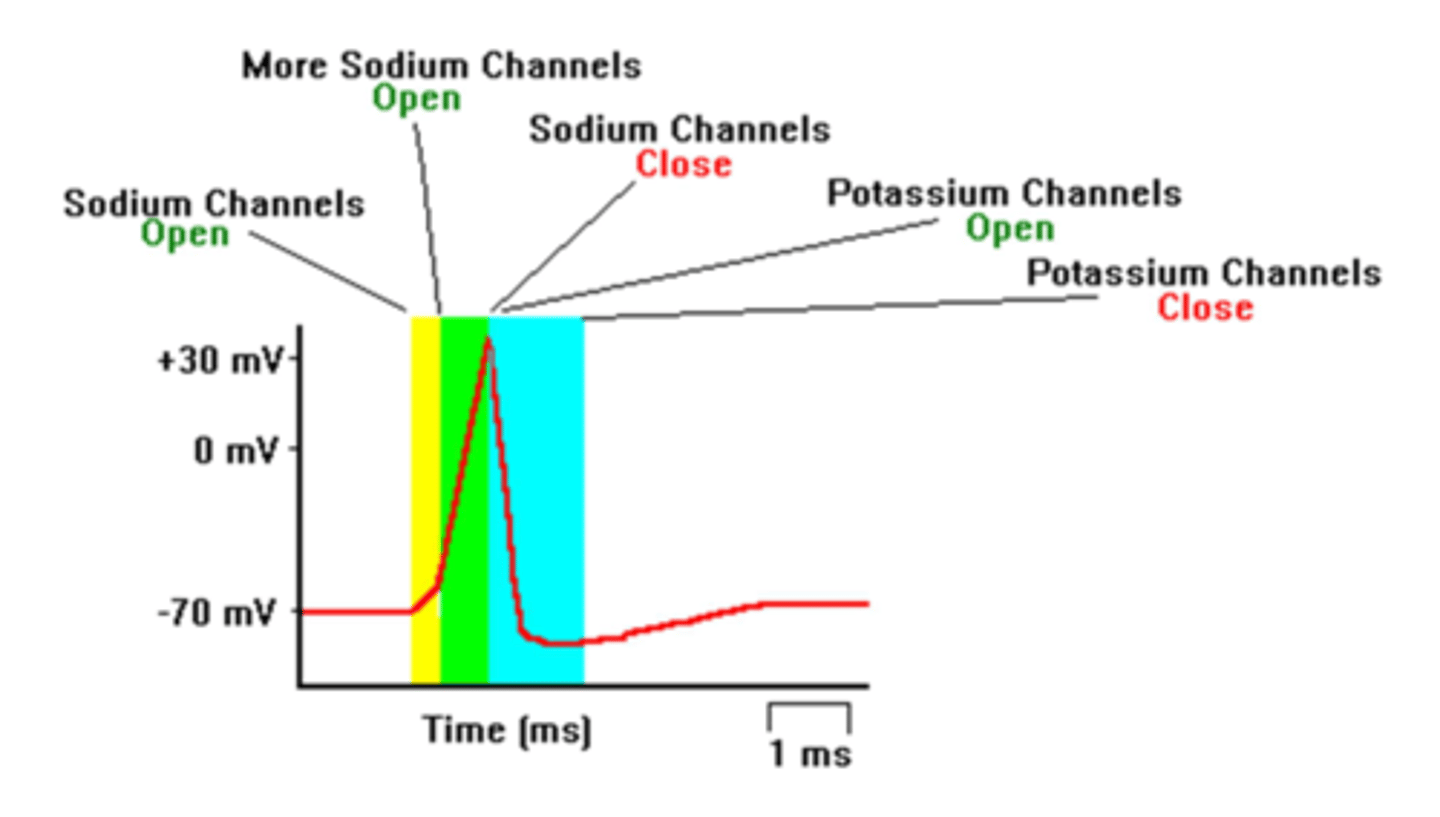
Refractory periods
the period of time following an action potential during which the neuron is incapable/less capable of firing an action potential: know absolute and relative.
Absolute refractory period
already firing an action potential, cannot fire another one.
can't multitask, can't fire two AP because the sodium channel won't reset
Relative refractory period
ions have been reset - difficult to fire an action potential because of undershoot.
but you can still fire it.
AP Summary (pt. 1)

AP Summary (pt. 2)
watch "lights, camera, action potential" to review.
https://www.youtube.com/watch?v=XdCrZm_JAp0
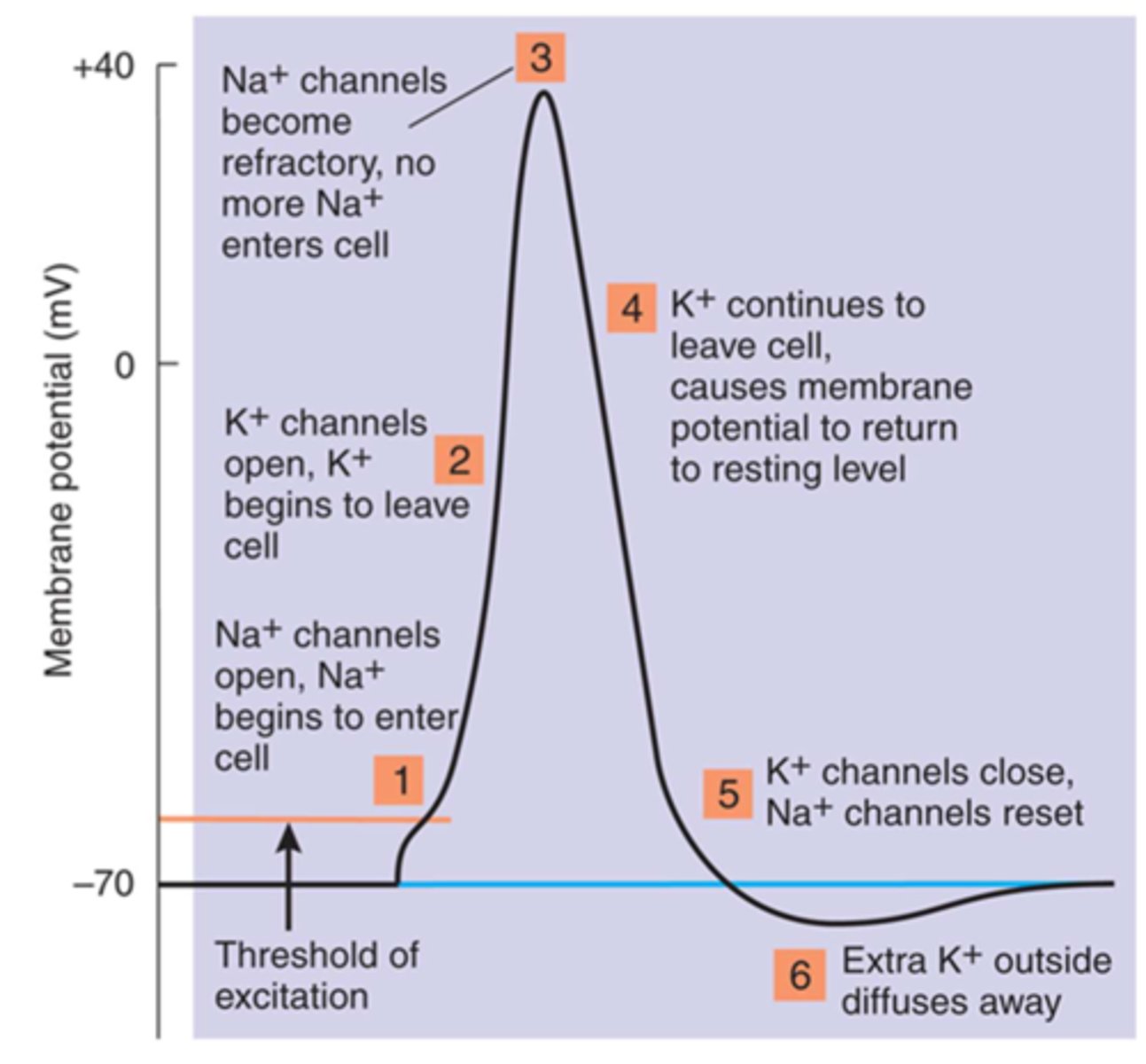
Change of ions across the membrane during an action potential at all stages and membrane potential?
refractory period determines that we only get FORWARD movement (hillock -> proper -> terminal).
All-or-none
Rate law
*AP will continue firing at the same rate until it lands at terminal.
rate law = how many AP are fired within a period of time
the stronger the stimulus, the more AP's there will be.
- fewer AP's = weaker stimulus
- greater AP's = stronger stimulus
Axon conductance velocity
larger size indicates faster conduction.
larger diameter = faster conduction.
Myelination
presence of myelin insulation lets it skip across proper, so only needs to recharge at node of ranvier.
- an unmyelinated axon would have to keep recharging (much slower).
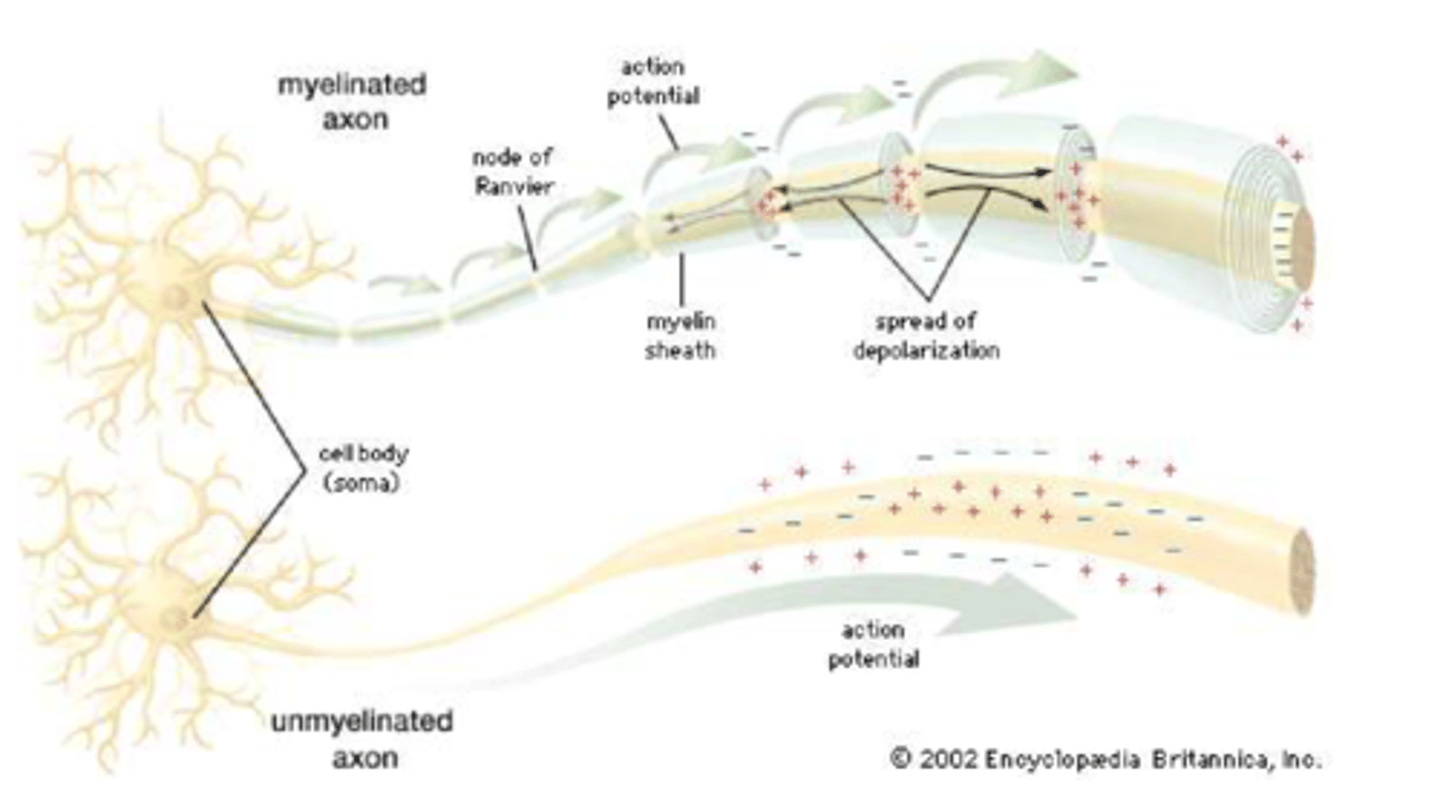
Saltatory conduction
can only happen in myelinated axon - the process of skipping through axon by myelination.
Multiple Sclerosis (MS)
de-myelinating autoimmune disease.
- recognizes myelin as thing that should be killed.
- makes antibodies to bind to myelin and immune cells with destroy it.
- exposes parts of axon that should not be exposed.
- messes with the saltatory conduction.
- can occur in different cortexes, resulting in different symptom presentation (e.g. could have vision issues if occurs in occipital lobe)
- can recover sometimes if it hasn't harmed cell too much.
Types of Synapses
axodendritic, axosomatic, axoaxonic
Axodendritic
Terminal --> dendrite
Axosomatic
Postsynaptic element is the soma.
Axoaxonic
Presynaptic element is an axon terminal, postsynaptic element is an axon terminal.
Synaptic transmission
Electric signals converted to chemical signals
preloaded with neurons
Voltage-gated Ca2+ (still calcium Ca+)
activated when the sodium (positive) depolarizes the membrane.
*calcium is more concentrated on the outside -> calcium is driven into the cell.
Exocytosis
neurotransmitters are dumped into the synaptic cleft.
- calcium HAS to enter the cell to trigger neurotransmitter release.
- calcium signals to vesicles to move close to membrane of axon terminal.
Neurotransmitter receptors
Neurotransmitter can only bond to its designated neurotransmitter receptors (e.g. dopamine needs to bond to dopamine receptor)
- either excitatory or inhibitory
Ionotropic receptor
straightforward; two parts
1. binding site - where neurotransmitter connects (makes them selective, like dopamine-dopamine and seratonin-seratonin)
2. ligand-gated ion channel/pore - open/closed based on whether ligand is bound or not.
(ligand = chemical/molecule)
happens fast.
Metabotropic receptor
have a binding site, but no pore or ion channel.
when activated, they're slower than ionotropic, but bigger impact because multiple ion channels are opened at once.
G proteins
most common type of neurotransmitter bc they have a bigger impact.
transmembrane protein that controls cell activity.
Postsynaptic potential (local/graded potential)
electric signal bonding to either ionotropic or metabotropic
can take 2 forms; depending on neurotransmitter and receptor - could respond with:
- EPSP (excitatory postsynaptic potential): Na+ influx, depolarizing. The only way is with sodium
- or IPSP (inhibitory postsynaptic potential): Chloride (Cl-) influx, K+ efflux, hyperpolarizing so its more negative on the inside. blocking from sending signal
**inhibitory signals = super common, controls impulse, 40% are inhibitory.
passive movement.
Ion movement for ISPS and ESPS
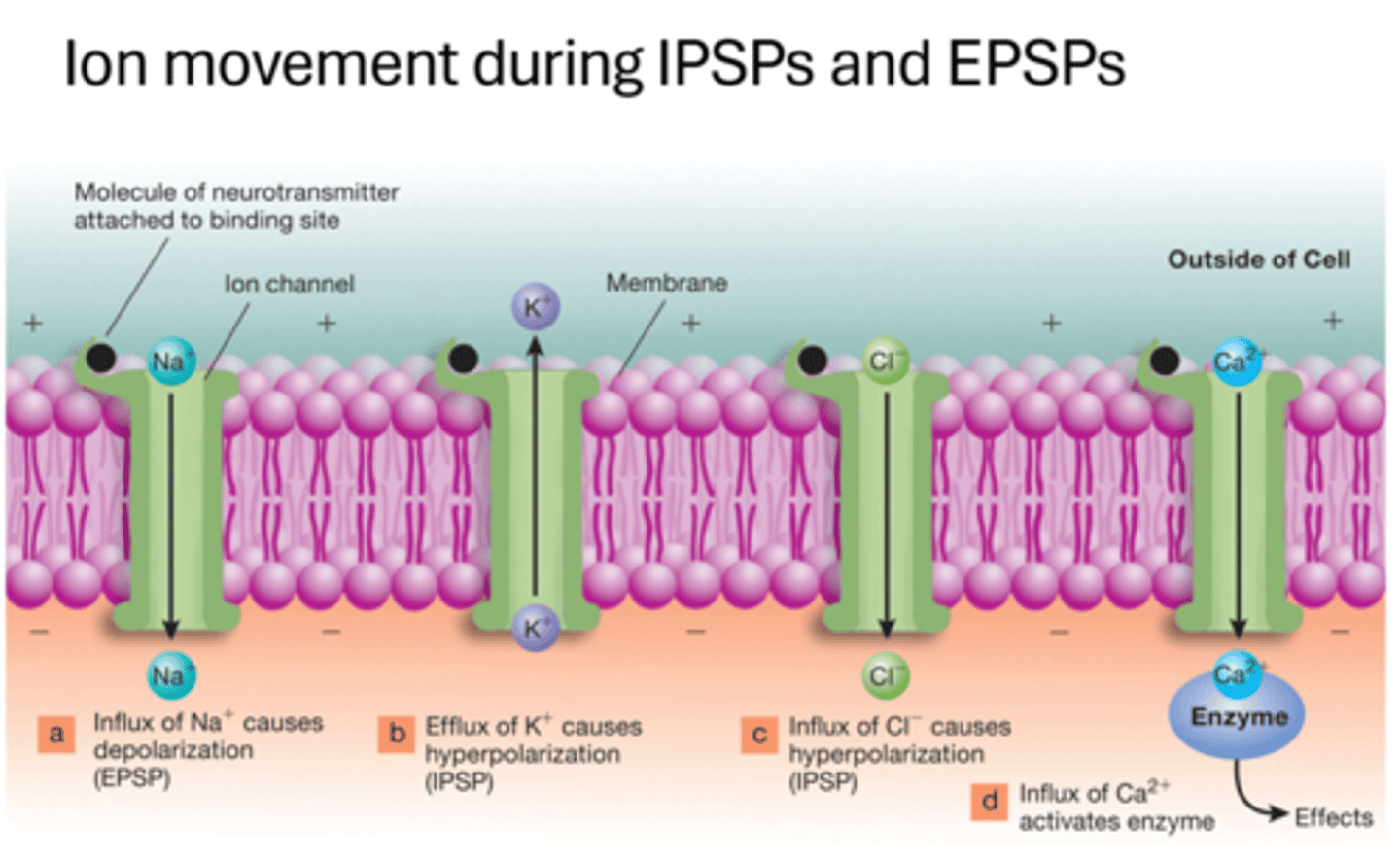
properties of EPSPs and IPSPs
local graded potentials
-stimulus strength, more likely to fire action potentials when stronger
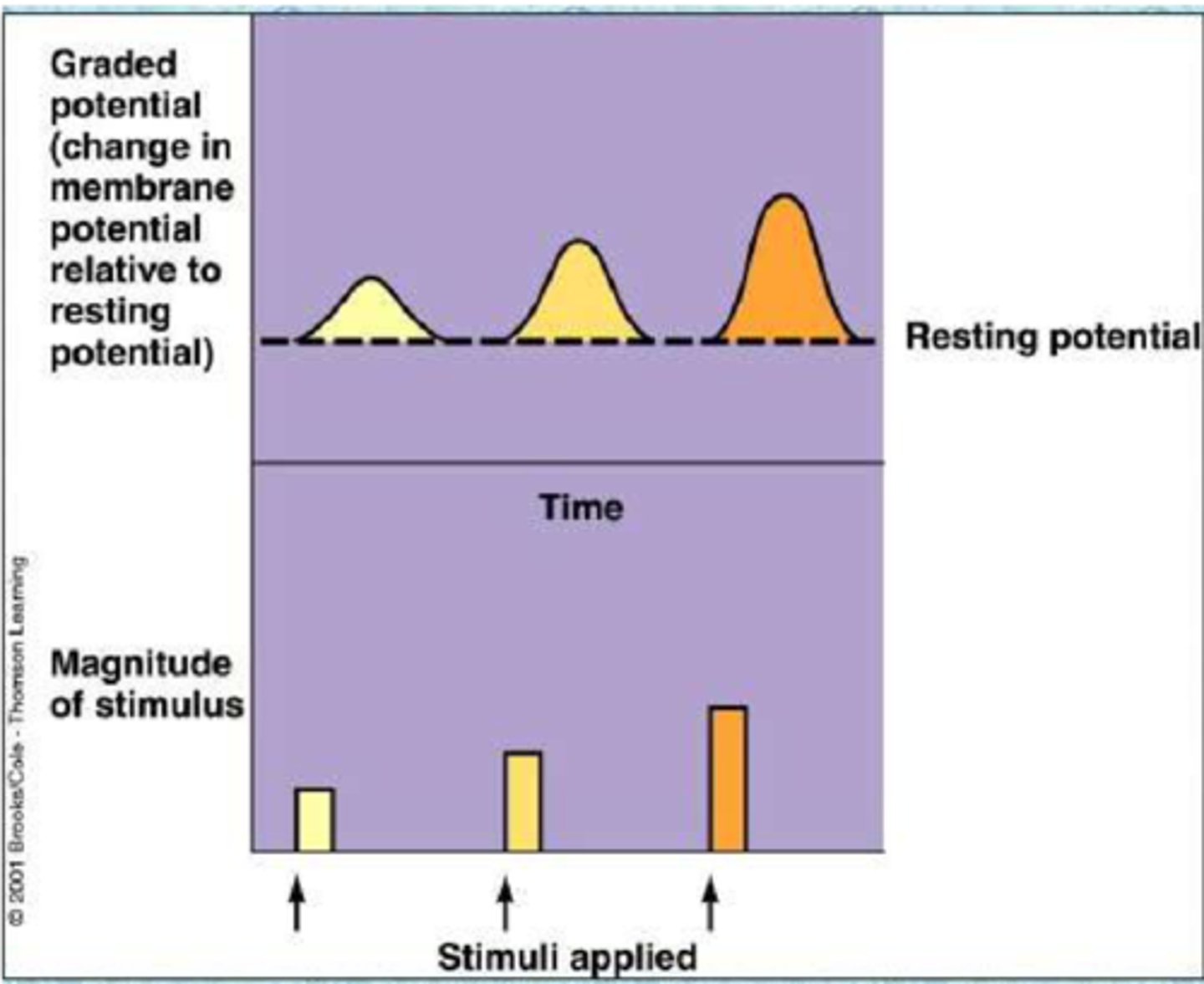
Integration of PSP and IPSP
- balancing act
- more excitatory or more inhibitory? (this determines whether axons fire or not).
cell is constantly integrating signals, determining above

- axon potentials come from axons
- epsps and ipsps happen in dendrites
watch lights, camera, action potentials rn.
Comparisons
picture in powerpoint
Synapse components
presynaptic membrane, postsynaptic membrane, synaptic cleft
Inactivation of neurotransmitters
• Neurotransmitter Reuptake in the adrenergic fiber
-transporter proteins found on pre-synaptic membrane. they mediate a reuptake, pull neurotransmitters back from the synaptic cleft. Can be reused a number of times until degraded.
Most common way
• Enzymatic deactivation taking place in synaptic cleft
-change a protein so its no longer that protein anymore. -ase at the end of a word means it's an enzyme (usually it's subparts). broken down into acetate + choline
second most common way
• Diffusion
-removed by astrocytes
Inactivation of neurotransmitters -Reuptake
"recycling."
transporter proteins - pulls neurotransmitters back inside neuron.
(e.g. removes dopamine from cleft, then pulls it back into the cell to reuse dopamine).
*going to have separate transporter protein for each type of neurotransmitter.
Degradation/Enzymatic deactivation
Enzyme
Acetylcholine
Acetylcholinesterase
Diffusion
the process by which molecules move from an area of higher concentration to an area of lower concentration
removed by astrocytes.